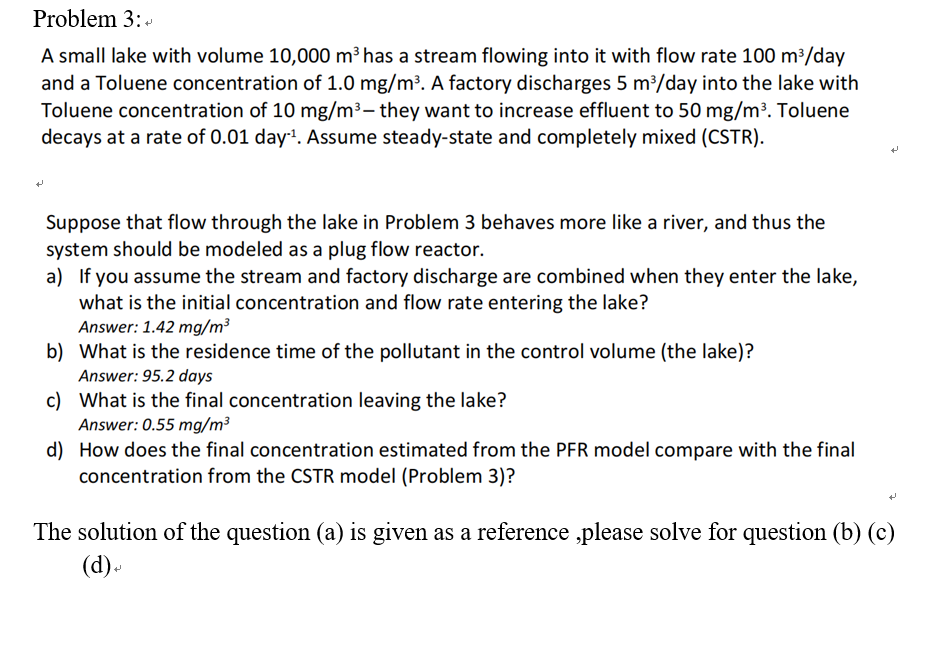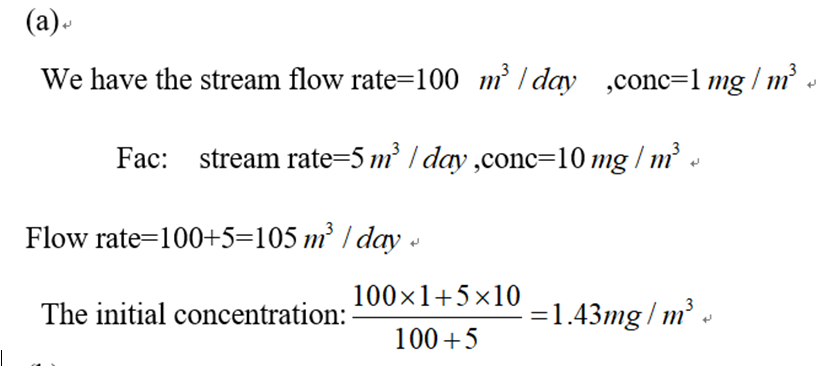Problem 3: A small lake with volume 10,000 m³ has a stream flowing into it with flow rate 100 m³/day and a Toluene concentration of 1.0 mg/m³. A factory discharges 5 m³/day into the lake with Toluene concentration of 10 mg/m³- they want to increase effluent to 50 mg/m³. Toluene decays at a rate of 0.01 day¹. Assume steady-state and completely mixed (CSTR). Suppose that flow through the lake in Problem 3 behaves more like a river, and thus the system should be modeled as a plug flow reactor. a) If you assume the stream and factory discharge are combined when they enter the lake, what is the initial concentration and flow rate entering the lake? Answer: 1.42 mg/m³ b) What is the residence time of the pollutant in the control volume (the lake)? Answer: 95.2 days c) What is the final concentration leaving the lake? Answer: 0.55 mg/m³ d) How does the final concentration estimated from the PFR model compare with the final concentration from the CSTR model (Problem 3)? The solution of the question (a) is given as a reference ,please solve for question (b) (c) (d)
Problem 3: A small lake with volume 10,000 m³ has a stream flowing into it with flow rate 100 m³/day and a Toluene concentration of 1.0 mg/m³. A factory discharges 5 m³/day into the lake with Toluene concentration of 10 mg/m³- they want to increase effluent to 50 mg/m³. Toluene decays at a rate of 0.01 day¹. Assume steady-state and completely mixed (CSTR). Suppose that flow through the lake in Problem 3 behaves more like a river, and thus the system should be modeled as a plug flow reactor. a) If you assume the stream and factory discharge are combined when they enter the lake, what is the initial concentration and flow rate entering the lake? Answer: 1.42 mg/m³ b) What is the residence time of the pollutant in the control volume (the lake)? Answer: 95.2 days c) What is the final concentration leaving the lake? Answer: 0.55 mg/m³ d) How does the final concentration estimated from the PFR model compare with the final concentration from the CSTR model (Problem 3)? The solution of the question (a) is given as a reference ,please solve for question (b) (c) (d)
Introduction to Chemical Engineering Thermodynamics
8th Edition
ISBN:9781259696527
Author:J.M. Smith Termodinamica en ingenieria quimica, Hendrick C Van Ness, Michael Abbott, Mark Swihart
Publisher:J.M. Smith Termodinamica en ingenieria quimica, Hendrick C Van Ness, Michael Abbott, Mark Swihart
Chapter1: Introduction
Section: Chapter Questions
Problem 1.1P
Related questions
Question
100%

Transcribed Image Text:Problem 3:+
A small lake with volume 10,000 m³ has a stream flowing into it with flow rate 100 m³/day
and a Toluene concentration of 1.0 mg/m³. A factory discharges 5 m³/day into the lake with
Toluene concentration of 10 mg/m³- they want to increase effluent to 50 mg/m³. Toluene
decays at a rate of 0.01 day¹. Assume steady-state and completely mixed (CSTR).
Suppose that flow through the lake in Problem 3 behaves more like a river, and thus the
system should be modeled as a plug flow reactor.
a) If you assume the stream and factory discharge are combined when they enter the lake,
what is the initial concentration and flow rate entering the lake?
Answer: 1.42 mg/m³
b) What is the residence time of the pollutant in the control volume (the lake)?
Answer: 95.2 days
c)
What is the final concentration leaving the lake?
Answer: 0.55 mg/m³
d) How does the final concentration estimated from the PFR model compare with the final
concentration from the CSTR model (Problem 3)?
The solution of the question (a) is given as a reference ,please solve for question (b) (c)
(d)

Transcribed Image Text:(a)
We have the stream flow rate=100 m³/day ,conc=1 mg r/m³
Fac:_stream rate=5 m³ / day,conc=10 mg / m³ «
Flow rate=100+5=105 m³ / day
The initial concentration:
100×1+5×10
100+5
=1.43mg/m³
Expert Solution
This question has been solved!
Explore an expertly crafted, step-by-step solution for a thorough understanding of key concepts.
This is a popular solution!
Trending now
This is a popular solution!
Step by step
Solved in 4 steps with 6 images

Recommended textbooks for you

Introduction to Chemical Engineering Thermodynami…
Chemical Engineering
ISBN:
9781259696527
Author:
J.M. Smith Termodinamica en ingenieria quimica, Hendrick C Van Ness, Michael Abbott, Mark Swihart
Publisher:
McGraw-Hill Education

Elementary Principles of Chemical Processes, Bind…
Chemical Engineering
ISBN:
9781118431221
Author:
Richard M. Felder, Ronald W. Rousseau, Lisa G. Bullard
Publisher:
WILEY

Elements of Chemical Reaction Engineering (5th Ed…
Chemical Engineering
ISBN:
9780133887518
Author:
H. Scott Fogler
Publisher:
Prentice Hall

Introduction to Chemical Engineering Thermodynami…
Chemical Engineering
ISBN:
9781259696527
Author:
J.M. Smith Termodinamica en ingenieria quimica, Hendrick C Van Ness, Michael Abbott, Mark Swihart
Publisher:
McGraw-Hill Education

Elementary Principles of Chemical Processes, Bind…
Chemical Engineering
ISBN:
9781118431221
Author:
Richard M. Felder, Ronald W. Rousseau, Lisa G. Bullard
Publisher:
WILEY

Elements of Chemical Reaction Engineering (5th Ed…
Chemical Engineering
ISBN:
9780133887518
Author:
H. Scott Fogler
Publisher:
Prentice Hall


Industrial Plastics: Theory and Applications
Chemical Engineering
ISBN:
9781285061238
Author:
Lokensgard, Erik
Publisher:
Delmar Cengage Learning

Unit Operations of Chemical Engineering
Chemical Engineering
ISBN:
9780072848236
Author:
Warren McCabe, Julian C. Smith, Peter Harriott
Publisher:
McGraw-Hill Companies, The